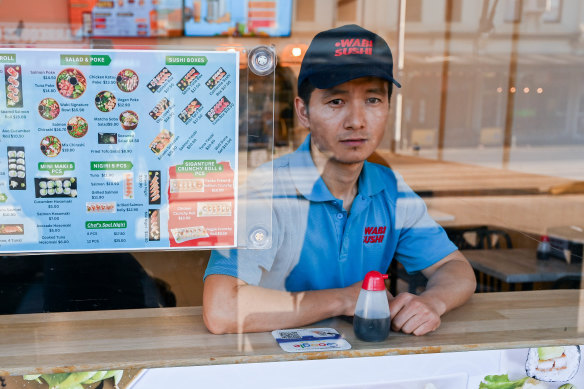This was published 9 months ago
A tale of two high streets: Why an Armadale shop is thriving while another in Richmond is ‘just surviving’
Justin Kestelman’s homewares store in Armadale opened eight months ago and is doing a “fantastic trade”. Across the Yarra in Richmond, Dagelbu Sherpa’s sushi shop is “just surviving”.
Their different circumstances aren’t a reflection of Melbourne’s age-old north/south divide, but instead illustrate the cost-of-living crunch and differing fortunes of suburban shopping strips.

Dagelbu Sherpa at Wabi Sushi on Bridge Road.Credit: Joe Armao
Kestelman acknowledges his customers aren’t as affected by Australia’s rising cost of living, soaring inflation and high interest rates.
“Local shoppers are in the higher socioeconomic [demographic] and are probably seeing less of an impact from interest rates. We definitely are still seeing a fantastic trade period in Armadale. We couldn’t be happier with the results,” he says.
High Street, where his fashionable homewares shop Hommey is located, bustles with well-heeled customers – a fact evidenced in the street’s prime vacancy rate, which, at 2.3 per cent, is among the lowest of Melbourne’s suburban strips.
The Armadale strip has become the most expensive place in suburban Melbourne to set up shop. Ultra-prime shopfronts command rent rates as high as $2000 per square metre.
“Retailers want the high foot traffic and spending power, and businesses want to be close to other strong traders,” says Fitzroys agent Lewis Waddell.
Top-shelf boutiques like Scanlan Theodore, Cos, Zimmermann, Camilla and Marc, and Rebecca Vallance line the street. Queensland fashion label Dissh, backed by retailing billionaire Brett Blundy, is the latest arrival.
Only Church Street in Brighton, another wealthy enclave, is performing better, but – surprisingly – its rents are significantly below High Street’s. Not so its vacancy rate, which is approaching zero, according to the latest Walk The Strip report from commercial agency Fitzroys.
Shops on Church Street are tightly held by investors that enjoy a secure income stream from quality tenants, who benefit from high foot traffic and local spending power, agents say.
So good is Kestelman’s business, he plans to expand.
With another shop open already on Toorak Road, South Yarra (vacancy 6.3 per cent), he expects to open a third in Fitzroy, quickly followed by a fourth in Chadstone next year.
Sherpa’s Wabi Sushi shop is on Richmond’s Bridge Road – a shopping strip plagued by high vacancy ever since it lost its once-thriving fashion trade to a wave of direct factory outlets opening around the city.
“We’re just surviving, I’d say. Sales haven’t been as steady as in the last two financial years.”
Dagelbu Sherpa owner of Wabi Sushi
Near the city end, vacancy is close to 15 per cent. Venture further east along the strip and the vacancy halves to a much healthier 7.2 per cent.
But that’s not the cause of Sherpa’s worries – he says foot traffic is fine. He opened his sushi shop during the pandemic and struck a good four-year rental rate that reflected the dire economic outlook in 2020.
Last month, he signed a new lease at a steeply increased rent. “When I signed up, it [rent] was OK, but now I’ve finished the first term, rent is, like, crazy. They’ve increased the rent almost 40 per cent.”
Coupled with suppliers ramping up the cost of his ingredients – an impost he hasn’t yet passed onto customers – he is now treading water. “We’re just surviving, I’d say. Sales haven’t been as steady as in the last two financial years,” Sherpa says.
While he does contemplate increasing his prices, he intends to trade his way out of stasis by opening another shop on Glenferrie Road in Hawthorn, where vacancy is a respectable 6.3 per cent.
Of the 37 shopping strips surveyed by Fitzroys, 26 – just over 70 per cent – recorded a vacancy rate below the long-term average. The number of strips that saw an increase in vacancy and those that saw a decrease in the past year were, essentially, evenly split.
Food and beverage has consolidated its strong performance, making up 31 per cent of suburban strip shops. Service retail lifted again, to a long-term high of 28 per cent, specialty retail jumped to 34 per cent, and the proportion of development sites on shopping strips fell to just 0.7 per cent as projects were completed.
“Regardless of what’s been thrown at them, our strips have remained our favourite places to live, work and play,” says Fitzroys associate director James Lockwood.
The Market Recap newsletter is a wrap of the day’s trading. Get it each weekday afternoon.